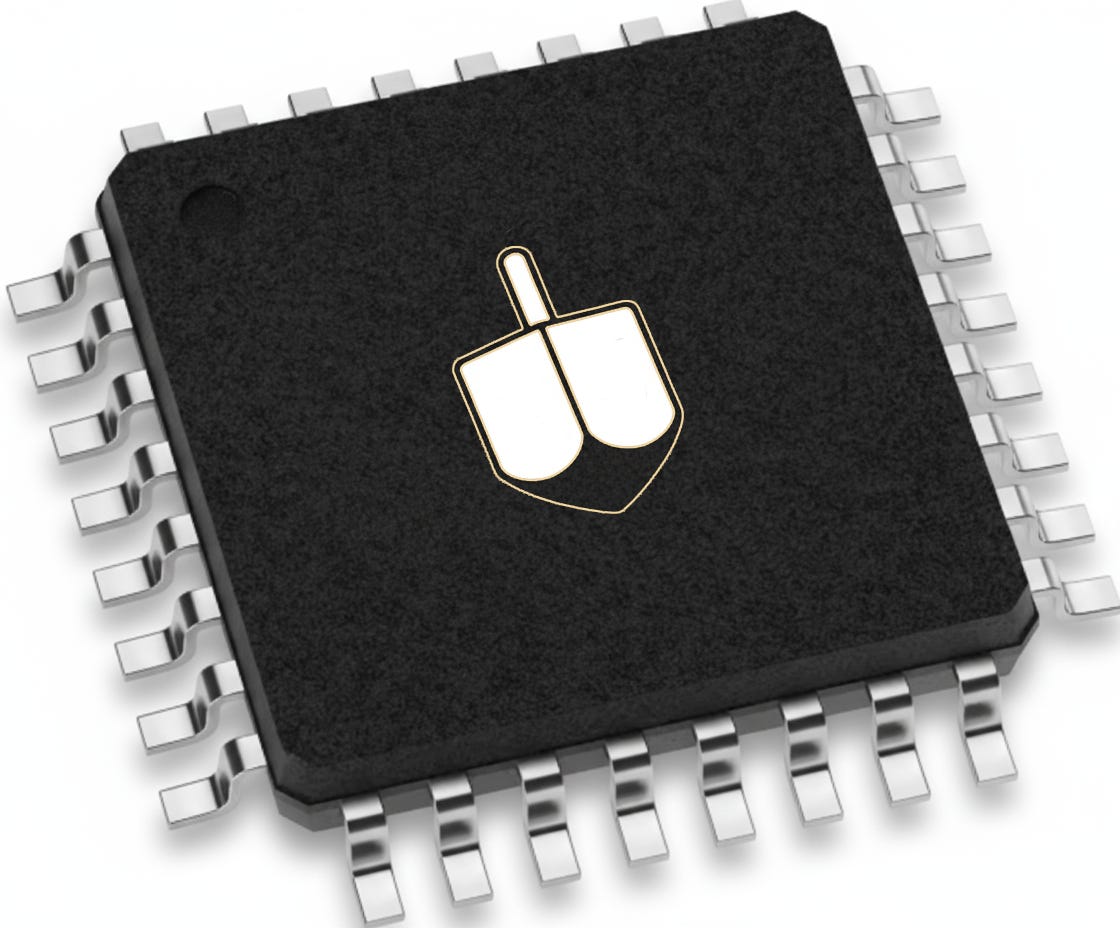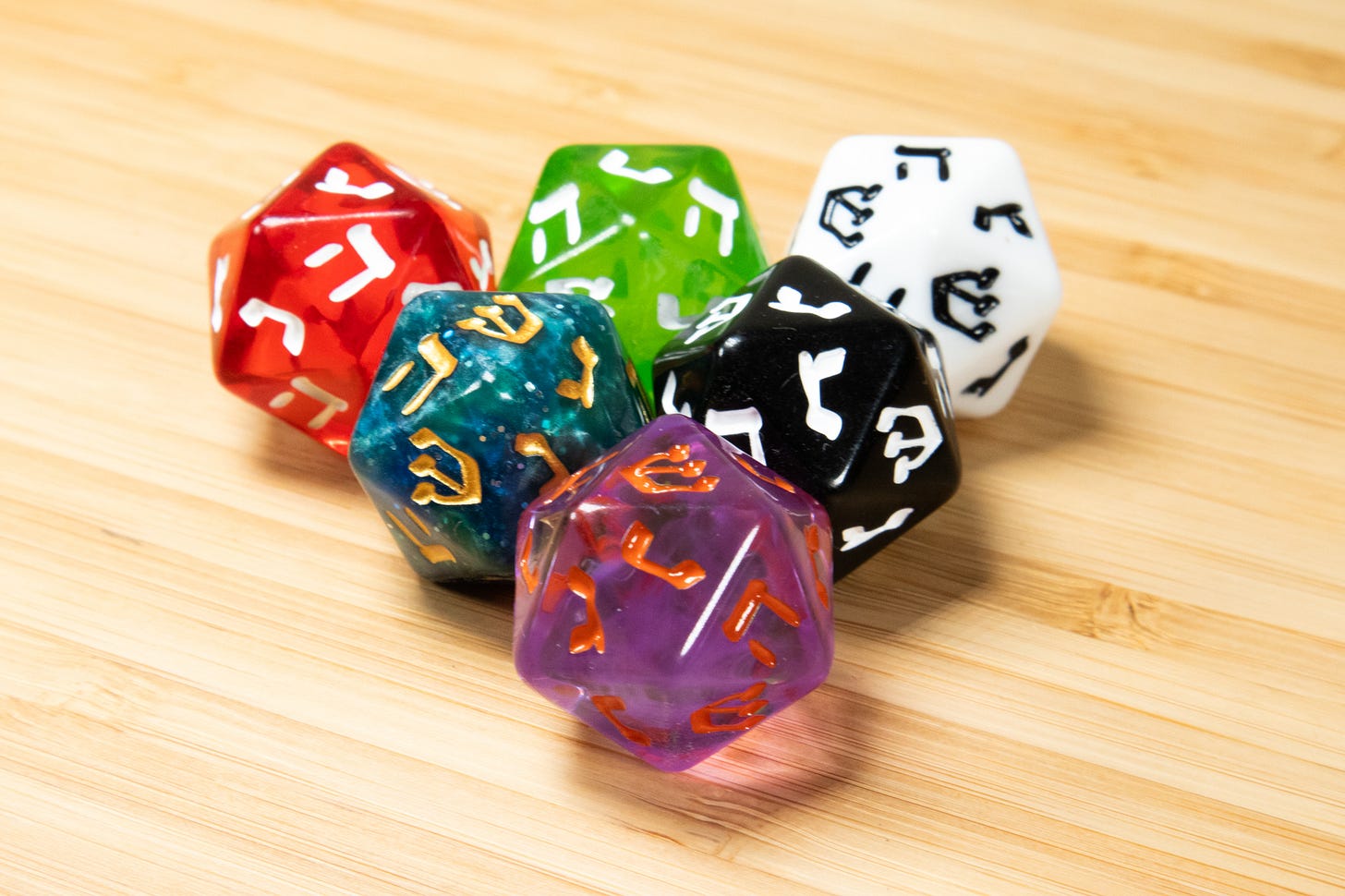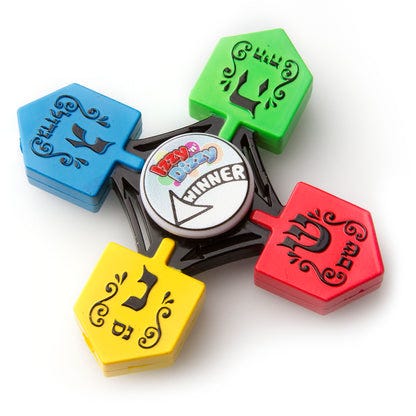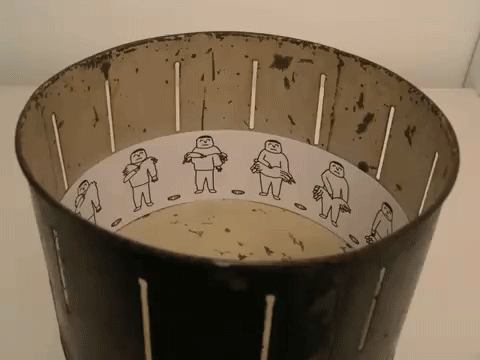The Dreidel of the Future, Part One
A USB port. Diaspora and Israel modes. Hackable. You've never seen anything like it. Why am I making it?
Of all the work that I do, creating dreidels is the most frivolous. They’re literal toys, tools in a game that itself is terribly designed. Nobody likes playing dreidel for more than a few minutes. They are the least important part of one of the least important holidays.
But the dreidel is also very malleable. It’s a quasi-religious object that’s also a game device—and because it serves no ritual function, you can’t really make it “wrong.” If people love your redesign, you’ve won.
In the past few years I have accidentally built myself a little dreidel empire. The Dreidel20—a twenty-sided die that is statistically identical to a regular dreidel (this is literally how it is advertised)—is sold in both Judaica and game stores all across America, and people buy thousands of them every year. People are tickled by the shape, which is great for me because I patented it. I’m not going to retire off dreidel money, but the profits are meaningful supplementary income.
Most people don’t make money playing with dreidels. I’m one of the few people who do.
But the profits don’t make the product less silly. Against the other things I work on—AI, psychedelics, Jewish futurism—it simply doesn’t register. If I was smart I would just take the win, enjoy the income stream, and move on.
But I keep coming back to it. I keep talking about it. I think about dreidels, about how I might reinvent them next.
Why? Most of what I produce is intangible; at best, I’ll see the fruits of my labor bound in a physical book. Dreidels, on the other hand, feel solid; they’re good to hold, to roll around, to keep in your pocket as a lucky charm. Looking at them, I always think, “This did not need to exist—and yet it does.” The reality of that existence provides me with a simple delight. It feels audacious. Even if I never sold another dreidel, that delight would remain.
A few years after the success of the Dreidel20, I decided to make a deluxe version. Instead of a crude pouch, I put the dice in a little black box with a black foam insert, as though they were little gems. I made the dice bigger, and also transparent—and then I had the manufacturer spend a “normal” dreidel inside of each one, as an homage to the toy’s origins.
It feels stupid to say that this little toy is a physical manifestation of how I see Judaism, but it is exactly that. The faith is reimagined—but the origins are still visible, embedded within, making the new more substantial, giving layers to something that would otherwise be flat. In time, the new will become embedded in something even newer. And on and on.
There’s more of myself in these dreidels than I’d like to admit. Maybe that’s why I was not able to stop myself from working on a new type of dreidel, this one unlike anything that exists on the market.
This is the story of a multi-year effort to make the dreidel of the future.
No, you can’t order it yet or even pre-order it (soon!), and the story is not yet complete. Today I want to tell you how it all started.
An even more popular spinning toy
One disadvantage of the Dreidel20 is that it makes the game very brief. A lot of the dreidel game is basically just waiting for the top to stop spinning, and a lot of the fun of the game is the spinning itself. The Dreidel20 is good for kids and people with dexterity issues, but it sucks something out of the game. I wanted to find a way to preserve the dreidel’s spin, but reimagined.
Enter the fidget spinner.
Fidget spinners haven’t been cool in a long time—they peaked in 2017—but in their heyday the idea of dreidelizing them occurred to several people. There are variations on the dreidel fidget, but they all basically look like this.
These fidgets are cute, but they have a problem: they’re not functional dreidels. Sure, you could arbitrarily stop the fidget spinning, but there’s no natural way to decide what its orientation means because it never definitively “lands” on anything. The payoff is weak. They’re fine fidgets but they’re not really dreidels at all.
So a normal fidget doesn’t work—but a subspecies of fidget could.
Enter the POV fidget
Amid the fidget craze, a few electronics-oriented folks noticed the same thing: The high speed of the fidget’s blades was more than sufficient to support a persistence of vision (POV) effect display.
POV displays are very old. The zoetrope, often described as an ancestor of motion pictures, is an early example. The basic idea is that at sufficiently high frame rates the brain fuses static images into fluid motion.
One of the cool things you can do with this effect is create an image from a single, fast-moving light source. Picasso famously did this, although the camera’s exposure is long than the effect in the human eye.
OK, but what about a line of light sources, like a column of LEDs? Well, if the LEDs speed across a given area while rapidly changing, they can create the illusion of a full image. If they speed across that same area repeatedly—moving back and forth or in a circle—you can create motion graphics. All from a single string of lights.
POV displays used to be expensive novelty gifts, the stuff of SkyMall catalogs. These days they’re very easy to make—the electronics are cheaper and plentiful—but they still have very few applications; whatever you want to do, a normal monitor will usually do it better. Worse, because POV displays are moving quickly they can cause injuries, are prone to failure, and rely on motors that use more energy than the common LCD display. The only interesting commercial application that I’ve seen is to put graphics on bike wheels.
Despite being niche, POV displays are often built by hobbyists because they’re not that complicated and they look cool—and since fidget spinners rotate quickly by nature (and are powered by hand, not motor), they were immediately recognized as good candidates for a POV treatment.
I have no idea who made the first POV fidget spinner, but they’ve been around since at least 2017. The website Hackaday records several prototypes posted in June of that year, including the image below comes from this article.
In the years since, many hobbyists have made similar devices. Sometimes they have three blades, sometimes they have bluetooth, but the basic design has remained the same: a circuit board in the shape of a fidget with a strip of LEDs on one blade, a microcontroller to handle the graphics, and a coin cell battery. That’s all you really need.

Despite their relative popularity, nobody seems to have figured out what to do with them. It’s notable that you can buy POV fidgets on AliExpress—but only as a soldering project, not as a ready-to-use toy. The idea is that they’re fun to build, but not that fun to use. With the fidget fad now firmly concluded, it didn’t seem like there was much interest in moving this hardware forward.
90% of a dreidel
I don’t remember the first time I saw a POV fidget spinner, but I do remember my immediate reaction: This is 90% of the way towards being a dreidel.
It rotates. It displays information. It can be randomized. All you need to do is program it to display Nun/Gimmel/Heh/Shin every time it’s spun.
Deliciously, such a device would reverse the meaning of the dreidel spin itself. Normal dreidels are inscrutable while in motion; you can read them only when they are still. A POV device does exactly the opposite: It displays no information while motionless but resolves each time it spins. The reversal itself was interesting to me—after all, who doesn’t want a dreidel that displays your result in lights that appear to be hovering in the air?
And so, I decided to make a POV fidget dreidel.
What about just putting a POV display in a standard dreidel?
In a perfect world, you might apply the POV effect directly to the body of a classic dreidel. In fact, a guy named Nathan Petersen did something very similar, and the final product looks great. The problem is that a dreidel spins too slowly (<1,000 RPM, vs. at least 2,000 RPM for a fidget and often far higher) and loses speed too rapidly. Perhaps you could give the dreidel an internal motor, but that would dramatically complicate the device and you’d lose the tactile joy of spinning the thing for yourself.

The path was clear: despite having no connection to the holiday, the fidget was a better form factor. Building on the success of my simple dice—and relying on the capital that its success had afforded me—I got to work.
This story will be continued.











